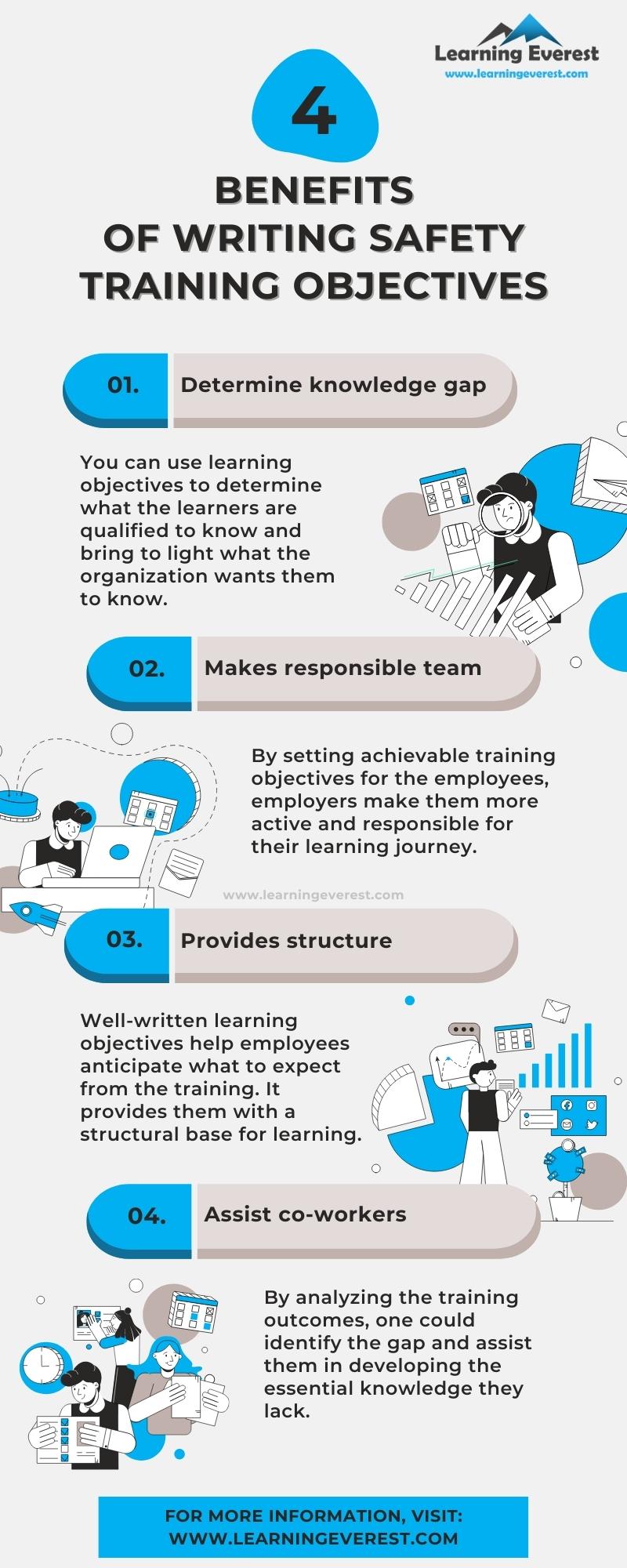Learning outcomes are described the training objectives of a training course. Developing learning objectives is essential in training and ultimately contributes to organizational success. Clear learning objectives are the best method to communicate to employees the substantial benefits of your training and get them on board wholeheartedly. This article will discuss how to write training objectives for safety training.
Table of Contents
Here are 7 steps to write safety training objectives
The following steps can help you formulate your safety training objectives and create an effective safety training program in your workplace:
1. Align the learning objectives with your safety goals
You create online training to improve employee safety training. So, the first step should be to align the training objectives with your business goals. Then, go back to your team and think about how their safety training will allow your organization to achieve its goals. Several questions to ask that can help you connect your training objectives to company goals include:
- How will this new safety skill, knowledge, or other outcome help the team contribute to the organizational goal?
- How do the desired outcomes contribute to organizational values?
- How will trainees’ development benefit overall productivity, performance, and the achievement of the organizational growth and revenue goals?
Questions like these can help you relate your training objectives to the overall achievement of your team, departments, and company’s business goals. This can also help ensure that the outcomes you develop will be realistic and attainable for trainees who participate. Once you are done, revisit the organizational goals and ensure they are consistent with your training objectives.
2. Keep the objectives short and simple
Remember to keep the training objectives short and to the point. Try to be as specific as possible. No need to go deep into detail about the learning material; focus on the learning outcomes. Use simple language, and do not make exaggerated statements. Otherwise, the training objectives will end up sounding like sales pitches.
3. Be specific
Training objectives should address a particular pain point, not generic learning outcomes. Employees like to learn what to expect from training. Ideally, it should be relevant to their needs. Training needs analysis (TNA) is the key to identifying the knowledge gaps and writing meaningful learning objectives. Take the time to carry out safety training assessments or on-the-job observations. It is the only way to find out where to focus your training.
4. Be realistic
Aiming high generally works well in life. But when it comes to safety training, it is best to set relevant and realistic safety training objectives. The results of your training needs analysis will help you estimate the present knowledge level of your team. You can then adjust your training objectives according to that, which, in turn, will allow you to express them more clearly. It would be best if you were careful about how much information you introduce in a course.
5. Identify challenges to safety training
As you outline activities and procedures that align with the desired safety outcomes of the training program, it is essential to identify any obstacles that could impede a trainee’s safety throughout the program. For example, creating activities and training procedures that account for everyone’s unique learning style may be difficult with a diverse team of employees. In that case, you can overcome this by taking a survey to see what kinds of methods your team members learn best with. This way, you can set achievable objectives for all trainees.
6. Use Bloom’s taxonomy
Well-written learning objectives help employees anticipate what to expect from the training. It provides them with a structural base for learning. Instructional designers can use Bloom’s taxonomy verbs for objectives globally to define the required cognition level in safety training to map the content type to the imagination or multimedia enablement of an eLearning course. Bloom’s taxonomy was first developed in 1956 by the American educational psychologist Benjamin Bloom. It is a classification of learning goals based on the cognitive processes involved. Each learning goal corresponds to a different level of learning. L&D professionals can use this six-stage taxonomy as a guideline for writing learning objectives.
You can learn more about Bloom’s taxonomy here!
7. Choose the correct verb
Objectives for development and training should motivate employees to join training by correctly pointing out the training outcomes. The verb you use to describe your learning objectives will determine your message’s clarity. Also, avoid generic verbs like learn, understand, be aware of, and prefer action verbs. They are more specific and measurable. Use Bloom’s Taxonomy to find the verb corresponding to your desired learning outcomes.
Conclusion
You would think that safety training courses speak for themselves, but that is different. You can use all the modern technologies you want. But specific and measurable learning objectives should be part of your safety training plan. So, dust up your writing skills and create learning objectives to help you set a clear learning journey and intrigue employees!
But if you want more ways to improve your safety training objectives, check out our blog on The Formula to Write Learning Objectives Like a Pro!
Infographic

4 Benefits of writing safety training objectives





